Anyone who owns a bare steel bar probably already knows that it takes regular oilings and brushing to keep these raw bars free of rust. We all know it, but not everyone does it; or at least not as often as they should.
If you are one who tends to neglect this minor chore long enough for oxidation to take over your bar, this article will show you a quick, easy way to deal with that rust and get your bar looking new again, and with very minimal effort.
I myself am generally really good about maintaining my barbells, but I have multiple bare bars to deal with, and two of them (Ohio Power Bar and Ohio Deadlift Bar) are used quite often and by multiple people. They not only get oiled less often because nobody wants to touch an oily bar, but the frequency that they are used and sweated on just increases the oxidation rate.
In any case, the Ohio Power Bar is the bar I chose to clean for this article, and I’m hoping to make a video using the Ohio Deadlift Bar.
Ohio Power Bar Before Cleaning
As you can see, this bar was getting pretty rusty. Honestly I don’t know how the sleeves got so out of control. I need to figure out who is putting their hands all over the sleeves and put a stop to that. Sleeves should not rust to this extent.
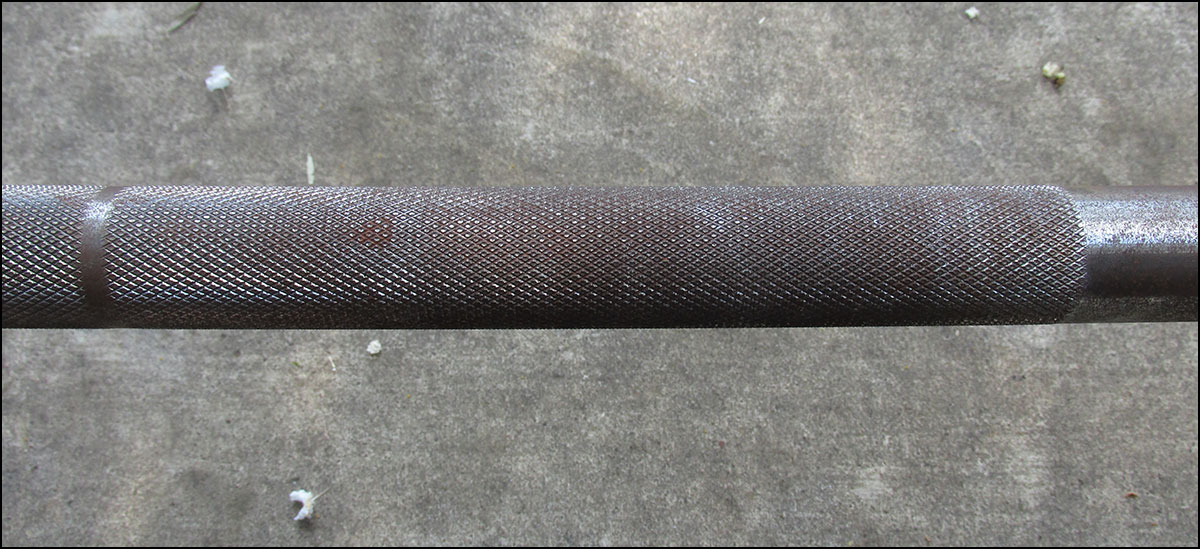
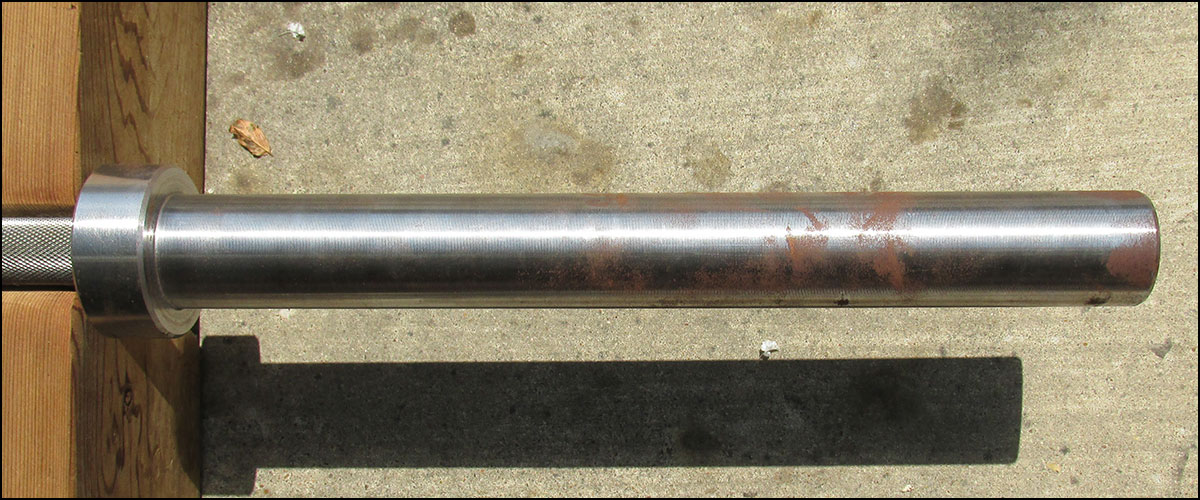
Now sure, you could take a normal, handheld wire brush like most folks tend to recommend to a mess like this, but you’ll be scrubbing that bar for hours. Or you can spend about $5 on a wonderful drill attachment and be done in 20-30 minutes. Yes the entire bar!
I got the brush pictured below at Home Depot, and I’m sure Lowes sells the same thing as well. You can also pick one up on Amazon without leaving the house. Regardless of where you get it, this wire wheel and some WD-40 is by far the fastest way to clean up a bar.
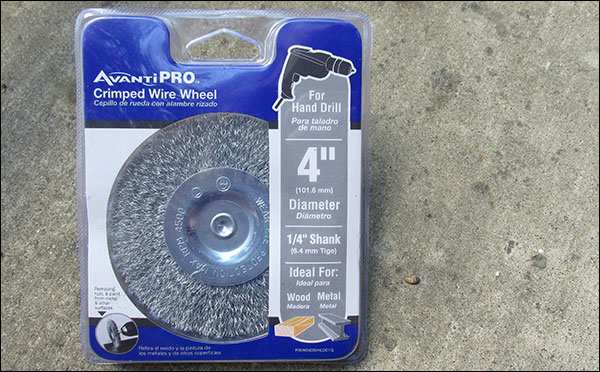
There isn’t much to explain in terms of what to do with it; it’s pretty self-explanatory. Put it in your drill, grab the safety goggles and your WD-40 (it’s better for removing rust than 3-in-1 oil), spray down the bar and go to town.
Of course you’ll want some shop rags and probably an old towel to catch the overspray that would otherwise end up on your garage floor or driveway, and ideally something to elevate the bar above the towel so you aren’t catching it with the wire, but other than that it’s pretty simple. Spray, brush, wipe down, and repeat on the stubborn areas.
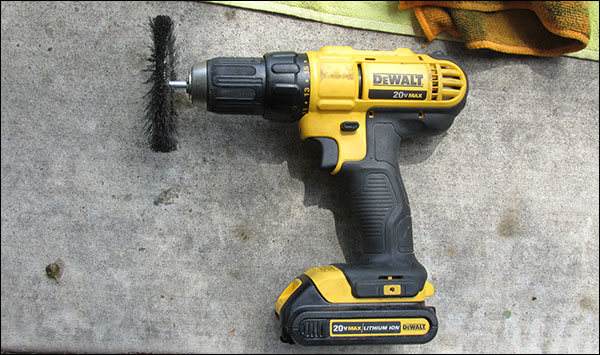
This wire wheel destroys rust, but using it runs through a 20v battery pretty fast. Use a corded drill if you have one. I had to switch after burning through two 20v batteries in 10 minutes.
When it’s all said and done and your bar looks new again, it’s as good a time as any to put a protective coat of 3-in-1 on the bar.
Ohio Power Bar After Brushing
The lighting wasn’t great because of the trees. Click to enlarge.
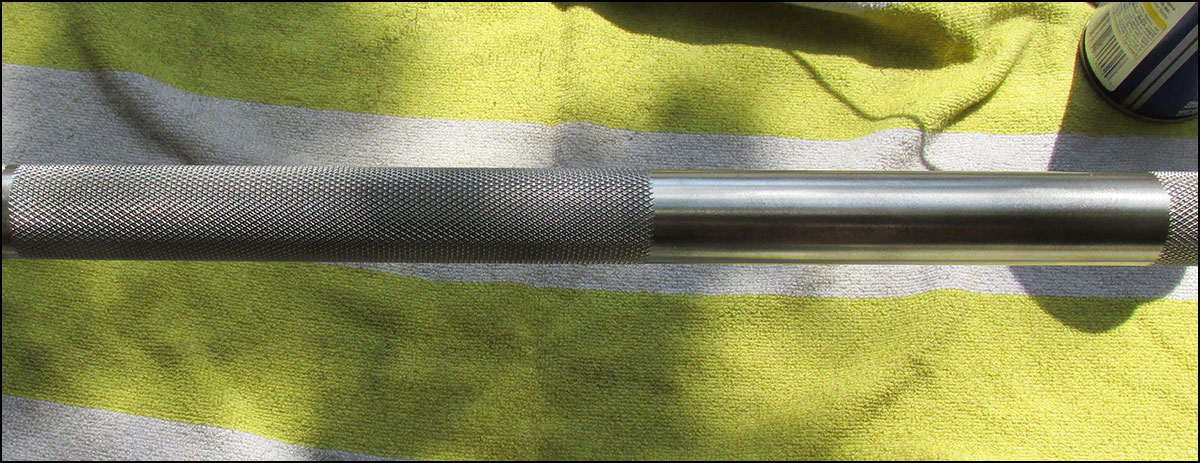
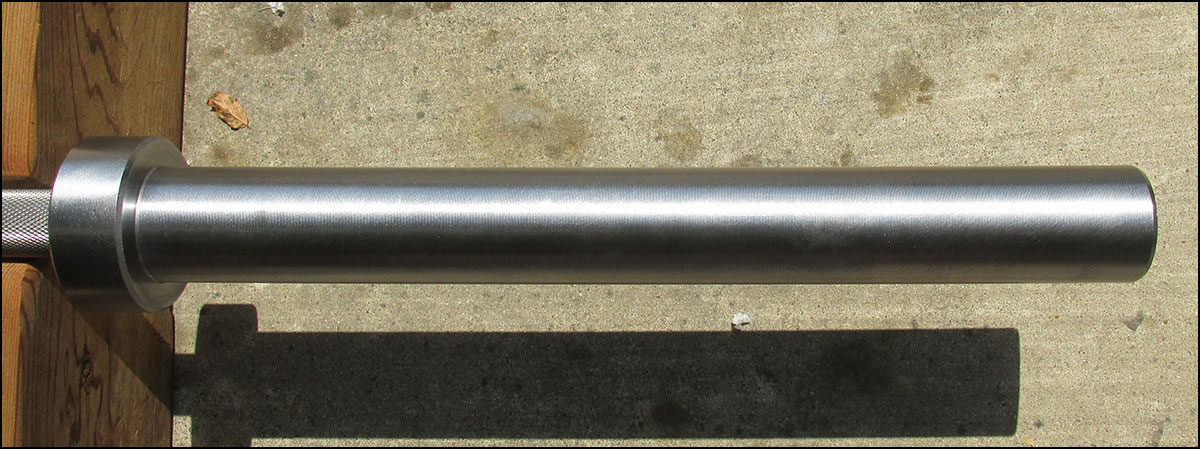
Now I won’t say it looks like it just came out of the shipping tube but still it looks pretty damn good; certainly nothing like it did before cleaning it! Raw barbell ownership is much less of a hassle when you have a decent power drill and a $5 crimped wire wheel (which incidentally lasts for a great many cleanings by the way.)
Here’s another before and after picture from a different angle.
Cleaning Tips
- Let the WD-40 soak into the oxidation a little bit before going at it with the wire brush.
- Do one 6-8″ section at a time. This has always proven quicker and easier for me to do 360º of one section before moving down the bar. It’s really easy to see where you’ve left off too (see below.)

It’s easy to see where you’ve already brushed
- Use a corded power drill if possible. Batteries die fast when running constantly, plus corded drills generally rotate much faster anyway. You’ll want to give a corded drill a break here and there because they can get hot when running constantly, but it beats waiting an hour for a battery to recharge.
- Elevate the bar somehow, and use a towel under it to catch the dripping oil. I just carved some simple notches into some old deck wood for a mini bar rack.
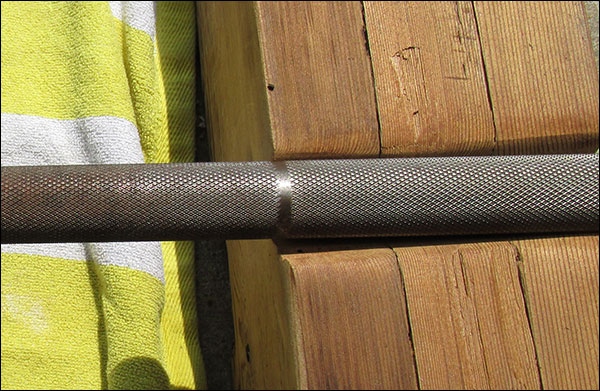
Simple 2″x6″ cedar blocks screwed together with a notch for supporting the barbell.
- Wear gloves; even those cheap $3/pair leather gardening gloves will do the trick.
- Wear safety goggles. The brush will start to shed wire after some use, and they come shooting out pretty fast when they do. You won’t notice if it hits your arm or something, but you don’t want one of those in the eye.
- Best tip: oil and brush your bar before it gets nasty so you don’t have to do this at all.
Summary
I realize that this isn’t groundbreaking information, but I know for a fact some of you are out there with a handheld wire brush just wasting half a day doing what this $5 drill attachment can do in a half an hour. I figured it was worth the minimal effort on my part to take some pictures and write something up.
Finally, do not take this wire brush to anything with a finish. Some finishes can handle this brush if you have some finesse and a variable speed drill, but I dare not even mention what those finishes are because you can just as easily strip that finish off, and I don’t want to be responsible for that. So officially, do NOT use ANY steel wire brush (handheld or wheel) on a finished barbell.

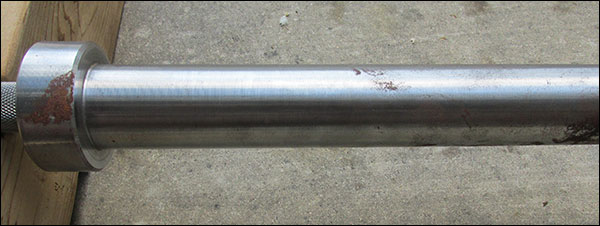
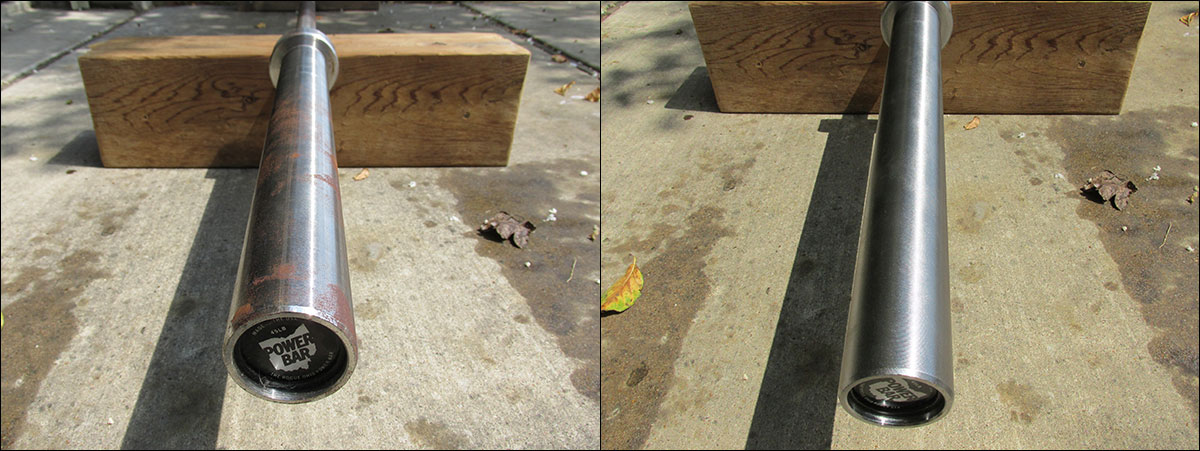

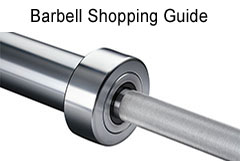
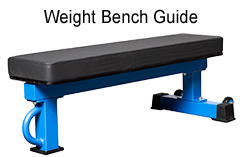
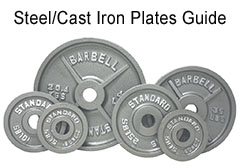
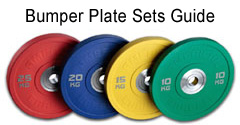
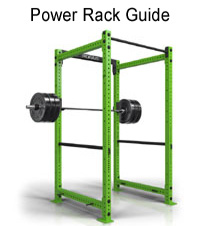


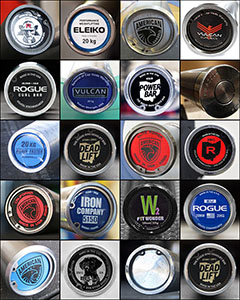


That’s a lot of effort and technology to deal with the problem. I’ve just slapped a coat of 3 in 1 oil every now and then. I also use that 00 steel wool to knock off any rust that’s on there by hand. I haven’t seen much on the sleeves, mostly on the knurls where I grab the bar with my sweaty digits. The bar is seasoning nicely.
Well of course, and I mentioned that this can be avoided with oil and regular maintenance. I’m just showing a quick way to undo neglect, not advocating a lack of maintenance.
Any risk of wearing down the knurl points over time? Just wondering if by using the drill method you would be tempted to put more pressure on the bar while cleaning, compared to a wire brush.
I’m sure it’s technically more likely, but in my experience the answer has still been no. Keep in mind that you can’t lean into it like it was a grinder or something like that; it’s not a firm attachment in that sense. You’re just hitting the bar with the very ends of the crimped wires; wires that are actually much thinner than the wire on handheld steel brushes. You’re just brushing a hell of a lot faster and hitting more surface area with each pass.
Ideally you don’t let it constantly get to the point it needs heavy cleaning, but my 5+ year old B&R has had this done to it at least four times so far and I could probably pawn that bar off as “very lightly used” even after all these years.
Great results can be achieved easily by using tinfoil and coke drink. Dip the foil in the coke then rub over rust, use rag to wipe excess. Cleans in seconds.
I live in Houston, TX and have a stainless steel rogue ohio barbell and I have noticed a couple of small rust spots on the knurling, do you think this would be effective for stainless steel as well, if it gets to the point I feel I need to do this? I do clean the chalk off after most sessions, and use 3-in-1 oil about once a month or so.
Stainless rarely gets rust build up, but given enough moisture (I realize the weather has been awful for Houston in recent days) it can oxidize. Being that stainless steel is a raw metal and not a finish, it too can be brushed and cleaned with wire brushes without any risk of damaging the steel. Light oxidation will actually probably come off super easy once WD-40 soaks in a minute.
The sleeves of that bar are chrome though, you’ll have to tackle any oxidation there with a plastic brush and a lot of elbow grease.
I’d suggest getting a brass wire wheel instead of steel. If you use phosphoric acid (someone mentioned Coke and that’s what’s in Coke that cuts rust — you can also buy the “CLR” product or something labelled as phosphoric acid cleaner). I’d tend to avoid Coke due to possible increased mess; I don’t see the purpose of the “tinfoil” mentioned above vs. a rag.
Chemical means would at least good for sleeves and can take rust out of pits that the brush might not reach. It leaves a bit of a sticky residue that d-limonene cleaners (clear orange) are good for removing but a little brushing in knurling is probably necessary.
Before the phosphoric acid it’s good to use acetone or d-limonene cleaner to get the oil off — phosphoric acid is in aqueous solution so needs the oil to be out of the way to be able to reach the rust.
Thank you for that info. Also why brass exactly? Softer?
Yes, brass is softer than steel so won’t leave scratches as a steel wheel might.
The reason for the tinfoil is twofold: http://www.slipperyrockgazette.net/index.cfm/pageId/1948
Thank you so much for this tutorial. I have a new (one-year-old) bare steel bar that is not used much, is kept indoors and rusted on the sleeves and pretty much everywhere else on the bar. I have not tried your method yet, but am extremely appreciative of the detailed outline of the steps and the specific recommendations. I have been so frustrated that my bar has been rusting so terribly even with the use of 4 in 1 oil from day one. You are 500% more helpful than the Rouge customer service team FYI – so thank you!
haha thank you very much. It’ll come clean. Eventually it will develop that patina and maintenance will be even easier.
Thank you so much for this little gem. My B&R 2.0 is looking great. I took 2 hours to clean it all up but it was worth it. As you say, not exactly like new but so much better.
Need to make sure it doesn’t get that bad again…
Thanks again.
Glad it helped!
It worked a treat, my friend. Thanks to you and the time you took to write up this handy little guide.
Much appreciated,
Just curious what to do once the rust is off how to clean it then so it’s not all gross and greasy? Thanks!
just use mild soap and water, but make sure to dry it well or you just invite more rust. Do it in such a way you don’t let water run into the sleeve assembly.